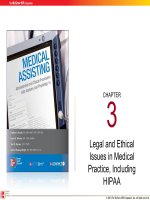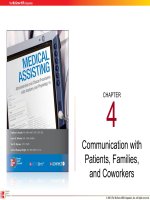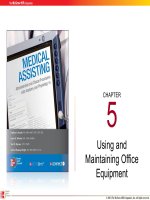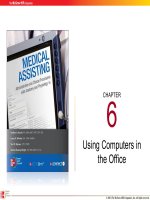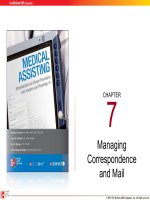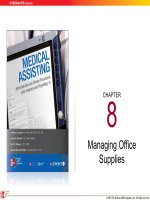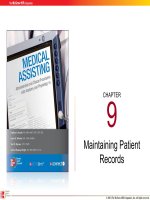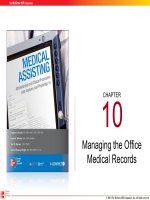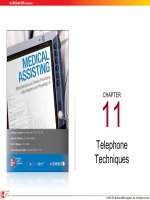Lecture Medical assisting: Administrative and clinical procedures with anatomy and physiology (4/e) – Chapter 31
Bạn đang xem bản rút gọn của tài liệu. Xem và tải ngay bản đầy đủ của tài liệu tại đây (1.92 MB, 75 trang )
CHAPTER
31
Special Senses
© 2011 The McGraw-Hill Companies, Inc. All rights reserved.
312
Learning Outcomes
31.1 Describe the anatomy of the nose and the
function of each part.
31.2 Describe how smell sensations are created
and interpreted.
31.3 Describe the anatomy of the tongue and the
function of each part.
31.4 Describe how taste sensations are created
and interpreted.
© 2011 The McGraw-Hill Companies, Inc. All rights reserved.
313
Learning Outcomes (cont.)
31.5 Name the four primary taste sensations and
the acknowledged fifth taste sensation.
31.6 Describe the anatomy of the eye and the
function of each part, including the accessory
structures and their functions.
31.7 Trace the visual pathway through the eye
and to the brain for interpretation.
31.8 Identify ways that patients can practice
preventive eye care.
© 2011 The McGraw-Hill Companies, Inc. All rights reserved.
314
Learning Outcomes (cont.)
31.9 State ways that vision changes with age.
31.10 List the medical professionals involved in
diagnosis and treatment of visual disorders,
including the roles that each play in patient
care.
31.11 List treatments for visual disorders.
31.12 Describe the causes, signs and symptoms,
and treatments of various diseases and
conditions of the eye.
© 2011 The McGraw-Hill Companies, Inc. All rights reserved.
315
Learning Outcomes (cont.)
31.13 Describe the anatomy of the ear and the
function of each part.
31.14 Explain the role of the ear in maintaining
equilibrium.
31.15 Explain how sounds travel through the ear
and are interpreted in the brain.
31.16 State ways that hearing changes with age.
© 2011 The McGraw-Hill Companies, Inc. All rights reserved.
316
Learning Outcomes (cont.)
31.17 List the types of hearing loss and how they
differ.
31.18 Describe treatments for ear and hearing
disorders.
31.19 Explain how patients can be educated about
preventive ear care.
31.20 Describe the causes, signs and symptoms,
and treatments of various disorders of the
ear and hearing.
© 2011 The McGraw-Hill Companies, Inc. All rights reserved.
317
Introduction
• Special senses
– Sensory receptors located in head
•
•
•
•
Nose – smell
Tongue – taste
Eyes – vision
Ears – hearing and equilibrium
Touch is a generalized sense
• Stimulus nervous system brain response
–
© 2011 The McGraw-Hill Companies, Inc. All rights reserved.
318
Nose and Sense of Smell
• Olfactory receptors
– Chemoreceptors –
respond to changes in
chemical
concentrations
– Chemicals must be
dissolved in mucus
– Located in the
olfactory organ
© 2011 The McGraw-Hill Companies, Inc. All rights reserved.
319
Smell Sensation
Activation of smell receptors
information sent to olfactory nerves
that send the information along
olfactory bulbs and tracts
to different areas of the cerebrum;
cerebrum interprets the information as a
particular type of smell
© 2011 The McGraw-Hill Companies, Inc. All rights reserved.
3110
Nose and Sense of Smell (cont.)
• Sensory Adaptation
– Chemical can stimulate receptors for
limited time
– Receptors fatigue and stop responding
to chemical
– No longer smell odor
© 2011 The McGraw-Hill Companies, Inc. All rights reserved.
3111
Apply Your Knowledge
You notice an odor coming from a patient when
you enter the exam room. Why would the patient
not be able to smell it?
ANSWER: After a few minutes, smell receptors undergo
sensory adaptation and no longer respond to the chemical,
and the patient can no longer smell the odor.
Very
Good!
© 2011 The McGraw-Hill Companies, Inc. All rights reserved.
3112
Tongue and Sense of Taste
• Gustatory receptors – located on
taste buds
• Taste buds
– Location
• Papillae of the tongue
• Roof of mouth
} fewer than on tongue
• Walls of throat
Tongu
e
© 2011 The McGraw-Hill Companies, Inc. All rights reserved.
3113
Tongue and Sense of Taste (cont.)
• Taste cells and supporting
structures
– On taste buds
– Supporting structures fill in space
– Taste cells
• Chemoreceptors
• Chemicals in food and drink must be
dissolved in saliva to activate
Tongu
e
© 2011 The McGraw-Hill Companies, Inc. All rights reserved.
3114
Tongue and Sense of Taste (cont.)
• Taste sensation
– 4 primary
• Sweet – tip
• Sour – sides
• Salty – tip and
sides
• Bitter – back
• Umami
– 5th basic taste
– Glutamic acid
• Spicy foods
– Activate pain
receptors
– Interpreted by brain
as “spicy”
Tongu
e
© 2011 The McGraw-Hill Companies, Inc. All rights reserved.
3115
Back
© 2011 The McGraw-Hill Companies, Inc. All rights reserved.
3116
Tongue and Sense of Taste (cont.)
Taste sensation
Activation of
taste cells
Cranial
nerves
Gustatory cortex of cerebrum
interprets information
© 2011 The McGraw-Hill Companies, Inc. All rights reserved.
3117
Apply Your Knowledge
What are the four primary taste sensations and
where are their corresponding taste cells
located?
ANSWER: The four primary taste sensations are:
Sweet – concentrated on the tip of the tongue
Sour – concentrated on the sides of the tongue
Salty – concentrated on the tip and sides of the tongue
Bitter – concentrated on the back of the tongue
© 2011 The McGraw-Hill Companies, Inc. All rights reserved.
3118
Eye and Sense of Sight
• Vision system
– Eyes
– Optic nerves
– Vision centers in
the brain
– Accessory
structures
• Eye
– Processes light
to produce
images
– Three layers
– Two chambers
– Specialized parts
© 2011 The McGraw-Hill Companies, Inc. All rights reserved.
3119
Eye and Sense of Sight (cont.)
• Outer – sclera
– White of the eye
– Protects the eye
– Sense receptors
– Cornea
• Front of eye
• “Window” that allows
light into eye
• Bends light as it enters
Eye
© 2011 The McGraw-Hill Companies, Inc. All rights reserved.
3120
Eye and Sense of Sight (cont.)
• Middle – choroid
– Contains blood
vessels
– Iris
• Colored part of eye
• Muscle that
contracts and
relaxes to open or
close pupil
• Regulates the
amount of light that
enters the eye
– Ciliary body
• Muscles
• Controls the shape
of the lens
– Lens
• Posterior to iris
• Focuses light on
retina
– Accommodation
Eye
© 2011 The McGraw-Hill Companies, Inc. All rights reserved.
3121
Eye and Sense of Sight (cont.)
• Inner – retina
– Visual receptors
• Rods
– Sensitive to light
– Will function in dim
light – “limited”
night vision
– Do not provide
sharp image or
detect color
• Cones
– Function in bright
light
– Sensitive to color
and provide sharp
images
– Optic disc – optic
nerve enters retina
Eye
© 2011 The McGraw-Hill Companies, Inc. All rights reserved.
3122
Eye and Sense of Sight (cont.)
• Chambers of the eye
– Anterior chamber
• Front of lens
• Filled with aqueous humor – nourishes and
bathes anterior eye
– Posterior chamber
• Behind lens
• Contains vitreous humor – maintains shape of
eyeball and holds retina in place
Eye
© 2011 The McGraw-Hill Companies, Inc. All rights reserved.
3123
Back
© 2011 The McGraw-Hill Companies, Inc. All rights reserved.
3124
Visual Accessory Organs
• Eye orbits
– Eye sockets
– Form a protective
shell around the
eyes
– Eyebrows protect
eyes
• Eyelids
– Skin, muscle, and
connective tissue
– Blinking
• Prevents surface
from drying out
• Keeps foreign
material out of eye
© 2011 The McGraw-Hill Companies, Inc. All rights reserved.
3125
Visual Accessory Organs (cont.)
• Lacrimal
apparatus
– Mucous membranes
• Conjunctivas
– Line inner surfaces
of eyelids
– Lacrimal glands
• Lateral edge of
eyeballs
• Produce tears
– Nasolacrimal
ducts
• Medial aspect of
eyeballs
• Drain tears into
nose
© 2011 The McGraw-Hill Companies, Inc. All rights reserved.

